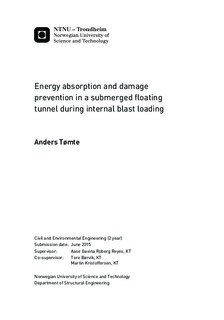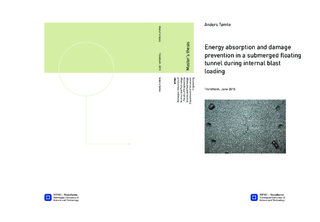| dc.contributor.advisor | Reyes, Aase Gavina Roberg | |
| dc.contributor.advisor | Børvik, Tore | |
| dc.contributor.advisor | Kristoffersen, Martin | |
| dc.contributor.author | Tømte, Anders | |
| dc.date.accessioned | 2015-10-05T15:16:55Z | |
| dc.date.available | 2015-10-05T15:16:55Z | |
| dc.date.created | 2015-06-09 | |
| dc.date.issued | 2015 | |
| dc.identifier | ntnudaim:13727 | |
| dc.identifier.uri | http://hdl.handle.net/11250/2351309 | |
| dc.description.abstract | Experiments on sandwich structures with an aluminum foam core and aluminum sheet plates are done in the shock tube facility at SIMLab. Aluminum foam is a lightweight material with many applications in a wide range of fields. It is a good energy absorber in uniaxial compression and therefore a great protective material. Additionally, aluminum foam is good at absorbing sound and has great fire resistance.
The Norwegian Public Roads Administration (NPRA) currently investigates the possibility of building a submerged floating tunnel across the Sognefjord. The investigation is part of a project to remove all ferries across the fjords along Norway s coastal highway (E39). An important consideration regarding the safety of such a structure is the resistance against explosions caused by an accident inside the tunnel or other sources.
When an explosion occurs, a blast wave will be generated and propagate away from the source. A shock tube facility is used to simulate the properties of a blast wave and for investigating blast effects on structures like sandwich plates with aluminum foam core.
Uniaxial compression tests on aluminum foam are performed to achieve the material properties before the sandwich plates are tested in the shock tube. A strain-hardening model for uniaxial and hydrostatic compression is calibrated with the stress-strain curves from the uniaxial compression tests. A power-law description is used to account for the density sensitivity of aluminum foam. The densities of the aluminum plates ranged from 0.21 to 0.42 g/cm3. Various degree of failure was observed in the foam for the different tests in the shock tube.
A numerical model have been created in Abaqus/Explicit as an attempt to simulate the shock tube experiments. A Matlab script provided the input parameters required for the simulations. Results from the analyses showed some similarities between the analyses and the experiments. The displacements were quite accurate, but the failure of the aluminum foam core were somewhat different in the numerical analyses compared to the experiments in the shock tube.
At the end, parameter studies are performed on sandwich structures with an equivalent thickness compared to monolithic aluminum plates, and on a concrete plate with an aluminum foam layer. The results from the equivalent thickness study showed that an equivalent sandwich structure did not performed better than the monolithic plate. From the analyses on concrete plates with an aluminum foam layer, the response in the concrete part increased when adding aluminum foam. | |
| dc.language | eng | |
| dc.publisher | NTNU | |
| dc.subject | Bygg- og miljøteknikk (2-årig), Beregningsmekanikk | |
| dc.title | Energy absorption and damage prevention in a submerged floating tunnel during internal blast loading | |
| dc.type | Master thesis | |
| dc.source.pagenumber | 108 | |

